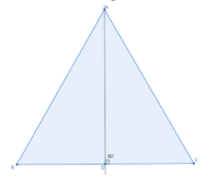
In an equilateral triangle ABC, AD$ \bot $ BC. Prove that $A{D^2} = 3B{D^2}$.
Answer
608.7k+ views
Hint: The altitude is also the median for an equilateral triangle. Use this property and the Pythagoras theorem (the square of the hypotenuse is the sum of the squares of the other two sides, in a right-angled triangle) to prove what is required.
ABC is an equilateral triangle. AD is perpendicular to BC.
AD$ \bot $ BC. So, AD is the altitude of triangle ABC.
Let us draw the diagram.

We know that, in an equilateral triangle the altitude is also the median.
Hence, D is the midpoint of BC.
BD=DC
We can also say that BD is half the length of BC.
$BD = \dfrac{1}{2}BC$ …(1)
We will use the Pythagoras theorem which states that the square of the hypotenuse is the sum of the squares of the other two sides, in a right-angled triangle.
In triangle ADB, AB is the hypotenuse.
$A{B^2} = B{D^2} + A{D^2}$
By rearranging we get,
$A{D^2} = A{B^2} - B{D^2}$ …(2)
We know that, in an equilateral triangle, all the sides are equal.
So, BC=AB …(3)
Using (3) in (1) we get,
$BD = \dfrac{1}{2}AB$
By cross-multiplying we get,
$AB = 2BD$ …(4)
Using (4) in (1) we get,
$
A{D^2} = {(2BD)^2} - B{D^2} \\
A{D^2} = 4B{D^2} - B{D^2} \\
A{D^2} = 3B{D^2} \\
$
Hence, $A{D^2} = 3B{D^2}$ is proved.
Note: In problems where we have to prove LHS=RHS, start from the LHS and take the proof in that direction as expressing the terms in terms of what is given in the RHS. This will lead to getting the correct RHS. Reasons must be written for each step while proving.
ABC is an equilateral triangle. AD is perpendicular to BC.
AD$ \bot $ BC. So, AD is the altitude of triangle ABC.
Let us draw the diagram.

We know that, in an equilateral triangle the altitude is also the median.
Hence, D is the midpoint of BC.
BD=DC
We can also say that BD is half the length of BC.
$BD = \dfrac{1}{2}BC$ …(1)
We will use the Pythagoras theorem which states that the square of the hypotenuse is the sum of the squares of the other two sides, in a right-angled triangle.
In triangle ADB, AB is the hypotenuse.
$A{B^2} = B{D^2} + A{D^2}$
By rearranging we get,
$A{D^2} = A{B^2} - B{D^2}$ …(2)
We know that, in an equilateral triangle, all the sides are equal.
So, BC=AB …(3)
Using (3) in (1) we get,
$BD = \dfrac{1}{2}AB$
By cross-multiplying we get,
$AB = 2BD$ …(4)
Using (4) in (1) we get,
$
A{D^2} = {(2BD)^2} - B{D^2} \\
A{D^2} = 4B{D^2} - B{D^2} \\
A{D^2} = 3B{D^2} \\
$
Hence, $A{D^2} = 3B{D^2}$ is proved.
Note: In problems where we have to prove LHS=RHS, start from the LHS and take the proof in that direction as expressing the terms in terms of what is given in the RHS. This will lead to getting the correct RHS. Reasons must be written for each step while proving.
Recently Updated Pages
Master Class 10 General Knowledge: Engaging Questions & Answers for Success

Master Class 10 Computer Science: Engaging Questions & Answers for Success

Master Class 10 English: Engaging Questions & Answers for Success

Master Class 10 Social Science: Engaging Questions & Answers for Success

Master Class 10 Maths: Engaging Questions & Answers for Success

Master Class 10 Science: Engaging Questions & Answers for Success

Trending doubts
The shortest day of the year in India

Why is there a time difference of about 5 hours between class 10 social science CBSE

Write a letter to the principal requesting him to grant class 10 english CBSE

What is the median of the first 10 natural numbers class 10 maths CBSE

The Equation xxx + 2 is Satisfied when x is Equal to Class 10 Maths

State and prove converse of BPT Basic Proportionality class 10 maths CBSE




